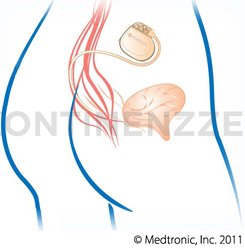Neuromodulation with the INTERSTIM system
Successful therapy of urinary urge incontinence or urinary retention

The urinary bladder and urethral sphincter are controlled by nerves that originate in nerve centres in the spinal cord and the brain. Nerves in the vegetative nervous system control the bladder and the internal urethral sphincter. We are only able to volitionally activate these vegetative nerve functions to a limited extent. The external urethral sphincter, on the other hand, is actively controlled and can be volitionally opened to allow urination and then closed again without leakage. Vegetative and volitionally controllable nerve tracts operate in close harmony and are connected by a series of reflex circuits. The healthy person can use these reflexes to control urination in line with his everyday activities. If this fine control mechanism is disrupted in any way, however, control and operation of the urinary tract are often disrupted as well. There are basically two conditions that can result from this: urinary incontinence and the opposite, an unability to empty the bladder.
Neuromodulation involves applying electrical impulses to stimulate fine nerve tracts. The intention is to restore the reflexes that are required for the urinary bladder and urethral sphincter to function properly. Electrodes are employed to stimulate certain nerve tracts in the sacral nerves, as this is where the nerve tracts and reflexes of the urinary tract congregate. Since stimulation has a modulating effect on the reflex pathways, it can be used to treat a series of different functional disorders of the bladder. Thus, the procedure is of equal help to patients with overactive and underactive bladders. Fine electrodes are placed on the sacral nerves in the lesser pelvis either through the skin or laparoscopically and connected to a battery-powered stimulator. Stimulation is then applied in a test phase lasting a number of days and the success ascertained. If the patient benefits from the stimulation, a stimulation system can be fully implanted just like a pacemaker.
